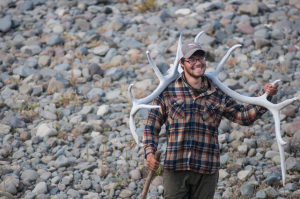“Looks like you owe us a six-pack when the course is over Sabrina!” Poor Sabrina had stepped out of her kayak as we all  pulled over to investigate an abandoned homestead along the river. She had placed her foot on what she thought was a compact surface, only to be deceived by many layers of mud that can give way. As she struggled to pull one foot free from the mud the other would sink in farther until grit and muscle came together to pull free her boots and wade to firmer ground. The Alaskan tradition of favors being called after a friend fills their rubber boots with water has made its way from the North Pacific to the banks of the Missouri River in central Montana. The boots though are not filled with the salt brine of the ocean but with the dark, silt rich waters of the Missouri River. This river has been known nationally as the “Big Muddy” since Mark Twain’s time, but one cannot understand how appropriate this name is until they themselves sink foot, ankle, calf, and knee into this mud. Some made scorn the sucking silt mud, but the mud is vital to the life along its riparian corridor, which supports the very ecology of the “Breaks” area of central Montana.
pulled over to investigate an abandoned homestead along the river. She had placed her foot on what she thought was a compact surface, only to be deceived by many layers of mud that can give way. As she struggled to pull one foot free from the mud the other would sink in farther until grit and muscle came together to pull free her boots and wade to firmer ground. The Alaskan tradition of favors being called after a friend fills their rubber boots with water has made its way from the North Pacific to the banks of the Missouri River in central Montana. The boots though are not filled with the salt brine of the ocean but with the dark, silt rich waters of the Missouri River. This river has been known nationally as the “Big Muddy” since Mark Twain’s time, but one cannot understand how appropriate this name is until they themselves sink foot, ankle, calf, and knee into this mud. Some made scorn the sucking silt mud, but the mud is vital to the life along its riparian corridor, which supports the very ecology of the “Breaks” area of central Montana.
The riparian corridor the snakes down the white cliffs and breaks section of the Missouri River supports a very unique biological community with the ever moving mud at its center. One of the most important parts of the Missouri’s riparian ecosystem is the cottonwood galleries. These cottonwood trees are large and give shade to the grasses so that they do not lose too much moisture to the sun’s heating rays. The better grasses and the shade attract a multitude of animals such as deer, elk, cattle, and coyotes. The trees help transform the river bottom to a lush oasis in contrast to the surrounding sagebrush desert.
Cottonwood trees are heavily dependent on the erosive properties of the river and the silt mud that is constantly being pushed downstream. To propagate, the cottonwood needs a lack of other vegetation on the ground for its seeds and it requires a lot of water to be successful. All of this can be achieved with a high river flow while seeds are being dispersed in the spring. The high water clears the ground of vegetation so that when the cottonwood seeds germinate they are without competition for resources. The cottonwood tree has a very deep root system so it can reach the water table and have a continuous supply of water through the long dry summers of central Montana, and area that usually receives about 10 inches of precipitation a year. The food waters also bring the tree high enough onto the riverbank where they will be safe from minor floods in the future.
The silt mud of the Missouri is very soft and easily eroded; this allows the cottonwood trees to have clear soil in which to grow in. The mud erodes so easily that in one single event the Judith River (a tributary of the Missouri) moved one half mile across its floodplain. This dramatic event allowed for the creation of vast new cottonwood galleries according to Chad Kraus, a hydrologist for the BLM.
The cottonwood is in trouble on the Missouri. Dams upstream of the breaks in Great Falls, Montana have regulated the river flows so that large flooding events no longer occur.
Aside from the vital regeneration of cottonwood trees along the Missouri, the Mud of the river allows for great fun to be had in the form of misadventures. Many shoes, boots, and sandals were almost lost while their owners tried to make it ashore. Only with a tug-of-war and the sound of the mud sucking would footwear be returned to its owner. I personally almost lost my river shoes (a pair of old Converse All-Stars) to the mud on the last day of our float. In the process of pulling my shoe out of the mud I could feel a tear and the soul of my shoe was then separated from its upper. The damage was heavy, but nothing duct tape couldn’t fix. This river can move the materials of life from bend to bend, unfortunately the materials of life on this river system are extremely sticky.
The Big Muddy’s erosive but subtle power gives life with the movement of mud in this harsh landscape that is beautiful beyond words I know.